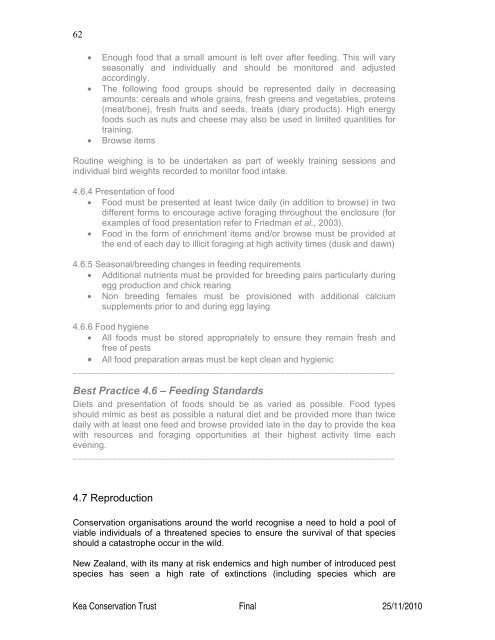(Nestor notabilis) Husbandry Manual - Kea Conservation Trust
(Nestor notabilis) Husbandry Manual - Kea Conservation Trust
(Nestor notabilis) Husbandry Manual - Kea Conservation Trust
You also want an ePaper? Increase the reach of your titles
YUMPU automatically turns print PDFs into web optimized ePapers that Google loves.
62<br />
• Enough food that a small amount is left over after feeding. This will vary<br />
seasonally and individually and should be monitored and adjusted<br />
accordingly.<br />
• The following food groups should be represented daily in decreasing<br />
amounts: cereals and whole grains, fresh greens and vegetables, proteins<br />
(meat/bone), fresh fruits and seeds, treats (diary products). High energy<br />
foods such as nuts and cheese may also be used in limited quantities for<br />
training.<br />
• Browse items<br />
Routine weighing is to be undertaken as part of weekly training sessions and<br />
individual bird weights recorded to monitor food intake.<br />
4.6.4 Presentation of food<br />
• Food must be presented at least twice daily (in addition to browse) in two<br />
different forms to encourage active foraging throughout the enclosure (for<br />
examples of food presentation refer to Friedman et al., 2003).<br />
• Food in the form of enrichment items and/or browse must be provided at<br />
the end of each day to illicit foraging at high activity times (dusk and dawn)<br />
4.6.5 Seasonal/breeding changes in feeding requirements<br />
• Additional nutrients must be provided for breeding pairs particularly during<br />
egg production and chick rearing<br />
• Non breeding females must be provisioned with additional calcium<br />
supplements prior to and during egg laying<br />
4.6.6 Food hygiene<br />
• All foods must be stored appropriately to ensure they remain fresh and<br />
free of pests<br />
• All food preparation areas must be kept clean and hygienic<br />
_________________________________________________________________<br />
Best Practice 4.6 – Feeding Standards<br />
Diets and presentation of foods should be as varied as possible. Food types<br />
should mimic as best as possible a natural diet and be provided more than twice<br />
daily with at least one feed and browse provided late in the day to provide the kea<br />
with resources and foraging opportunities at their highest activity time each<br />
evening.<br />
_________________________________________________________________<br />
4.7 Reproduction<br />
<strong>Conservation</strong> organisations around the world recognise a need to hold a pool of<br />
viable individuals of a threatened species to ensure the survival of that species<br />
should a catastrophe occur in the wild.<br />
New Zealand, with its many at risk endemics and high number of introduced pest<br />
species has seen a high rate of extinctions (including species which are<br />
<strong>Kea</strong> <strong>Conservation</strong> <strong>Trust</strong> Final 25/11/2010












